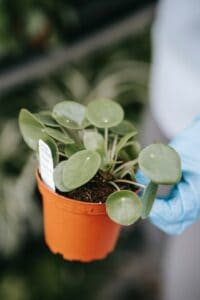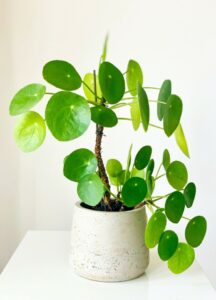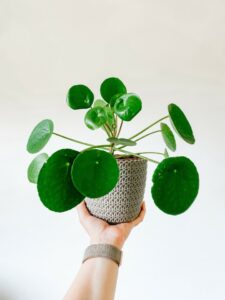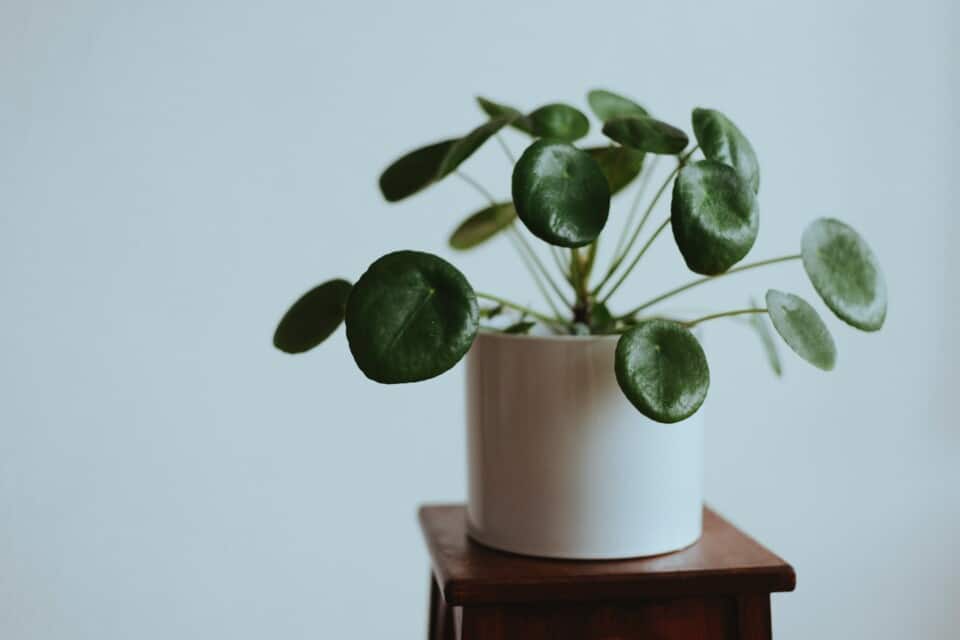Some links in the post are affiliate links and I get a commission from purchases made through some links found in the post.
The first time I noticed a brown spots on the leaves of my Pilea, I shrugged it off. “It’s just one spot. It’s nothing to lose sleep over,” I told myself and went about my business.
The brown spots multiplied over the next few days, and I could no longer bury my head in the sand. So, armed with a picture, I searched online for answers to why my plant was exhibiting signs of distress.
The reasons your pilea leaves turn brown are due to inadequate lighting, too much sun exposure, pest infestations, temperature variations, being rootbound, and lack of good watering practices.
The main reason for this is main due to overwatering so make sure before watering your pilea to check the soil.
And as I went through and checked my plant against each cause, I finally narrowed it down to the culprit causing me sleepless nights.
This guide takes you through the main causes of browning Pilea leaves and, most importantly, what you can do about it:
Why Are My Pilea Leaves Turning Brown?
Are you ready to find out why your Pilea could be ailing? These are the most common reasons:
Overwatering
 Have you given any thought to how much water you give your Pilea? If it’s leaves have turned brown, you could be too generous with the watering.
Have you given any thought to how much water you give your Pilea? If it’s leaves have turned brown, you could be too generous with the watering.
Here’s the thing about Pilea plants. They have succulent features which enable them to hold on to water for long periods. Thus, the extra water does not do it any favors.
If anything, it triggers water retention in the soil, which contributes to root rot. And if you don’t stop overwatering the plant, the root rot could eventually kill it. The brown spots are but a warning – the worst is yet to come.
The choice of a potting mix also affects the health of the plant. While you may not be overwatering the plant on purpose, the soil could be working against you.
Pilea plants prefer peat-based potting mixes as these are rich and well-draining. Other potting mixes may not be ideal and could create an environment that fosters root rot.
Underwatering
It’s almost impossible to touch on overwatering without reflecting on its opposite – giving the plant less water than it needs.
While the Pilea does not enjoy being soaked in water, it still needs some water. Even succulents cannot go for too long without some watering.
If you ignore the plant’s needs, it soon shows some yellow and brown spots. Moreover, it droops and could die if left in this state for too long.
Inadequate Light
The Pilea does best when exposed to bright and indirect light, as it can make food in this way. But when it does not get sufficient light, it suffers.
The leaves stop growing, and the stems start exhibiting leggy growth as they try to reach more light.
Moreover, the leaves stunt, and rather than grow large and round, they become smaller and start curling upwards. These are all indications that the plant does not get sufficient light.
For more information on getting the adequate light for a pilea we have created an article on the pilea light requirements.
Direct Sun Exposure
Too much of anything can be poison. And in the case of the Pilea, exposing it to direct sunlight can harm it rather than help it.
As indicated above, this plant thrives in bright and indirect light. And in such conditions, its leaves round out and become big.
But when exposed to direct sunlight, its leaves start browning and can even turn yellow. And unfortunately, this damage bars the plant from making food and is irreversible.
If more of its leaves get damaged, the plant grows weaker and could eventually die.
Rootbound Pilea
The good news is that the Pilea grows quite fast. But the downside to this is that you need to replace its pot every 1 to 1.5 years or so.
If this skips your mind, you could find yourself in a conundrum with the plant showing browning on its leaves. The reason behind this? – If the roots are bound, the plant cannot absorb enough nutrients to foster growth.
Temperature Variations
The Pilea prefers temperatures between 60- and 95-degrees Fahrenheit. If the temperatures are above or below this range, the plant can react by browning.
It results from temperature stress, more so when the temperature variations are sudden. For example, during the winter, Pilea leaves may turn brown when placed near a window which allows the entry of cold drafts.
The same could happen when you place the plant near a heating vent. To check if your plant is a victim of temperature changes, look out for scars and brown spots on the leaves after exposure.
If you’re enjoying this article, check out our article on what are the common problems with a pilea.
How To Stop My Pilea Leaves from Turning Brown?
Can you protect your Pilea from browning? Sure, you can! The Pilea only shows signs of distress when it does not get what it needs. And here is how you can address the pain points we discussed above:
Overwatering
 The easiest way to deal with overwatering (and underwatering) is to understand what the Pilea needs. Ideally, the plant needs water only when the soil is dry.
The easiest way to deal with overwatering (and underwatering) is to understand what the Pilea needs. Ideally, the plant needs water only when the soil is dry.
Of course, the frequency of this comes down to your climate. In some areas, you can water the plant once a week, and it will be fine.
And in others, you might need to water the plant every few days. The rule of thumb is to only water the plant when the top two inches of soil are dry.
Moreover, you should use the appropriate potting mix for your plant. And finally, always ensure that the pot has enough drainage holes and keep checking them to ensure they are not blocked.
Underwatering
Striking a balance between killing your plant with too much or too little water is not easy. But you cannot sit back and let nature take its course. Instead, here is how you deal with an underwatered plant:
- Assess the plant by looking at its leaves. An underwatered plant will have brown spots on its leaves, and its leaves will feel thin and crispy. They might even have folded.
- Check the soil to gauge if the top two inches of soil are dry. That’s a rule of thumb you must always follow when watering the Pilea.
- If the soil is dry, soak the soil in water by allowing water to run through the soil then letting the excess water drain through the drainage holes. Leave the plant be and give it time to absorb the water.
- Keep checking the plant to see if the top two inches are dry. When it’s time to water the plant again, give it a thorough soak and allow it to absorb the water.
You must maintain a consistent watering schedule that is flexible enough to account for changes in the climate.
And if you have a hard time sticking to the schedule or knowing if the plant needs water, get a moisture gauge. It will save you a lot of guesswork and help you care for the Pilea and other plants in the home.
Inadequate Light
Most Pilea species enjoy access to bright and indirect light. And when placed indoors in places with limited access to light, the plants suffer.
The easiest way to fix this is to reposition the plant. Move it to a section with partial shade/ partial sunlight. Ideally, this should be near a window.
To ensure the plant does not get exposed to full sun, you should use sheers on the window. Also, rotate the plant every two weeks to ensure that it grows evenly.
If your home does not have adequate access to sunlight, you can invest in grow lights to supplement what the plant gets from the daylight.
Can the Pilea die due to inadequate sunlight? Luckily, this plant can survive in low light conditions. But there is a caveat.
In such conditions, the plant’s leaves turn a dark green and become much smaller than they would ideally be. Moreover, they exhibit leggy growth, which can be pretty unsightly.
We have an article here on how to fix a leggy pilea to keep your plant looking beautiful.
Direct Sun Exposure
Sun damage is irreversible. However, here is how you can save what remains of your Pilea leaves:
- Get rid of the damaged leaves to leave room for new growth to thrive,
- Reposition the plant to a spot with bright and indirect light. Ensure that the plant does not get any full sun exposure.
- Avoid exposing the plant to the sun when its leaves are wet, which catalyzes further damage.
Over time, the plant will produce new foliage and will be able to sustain its growth by producing more food.
Rootbound Pilea
A rootbound plant needs to be repotted to allow the roots to absorb water and nutrients in the soil. All you need is to:
- Check for signs that the plant is rootbound: These include protruding roots, welling water at the top of the soil when you water the plant, and visible root binding.
- Find a pot that is an inch or two wider than the current pot and move the Pilea.
It should be at least a year before you need to move the plant again.
Temperature Variations
 Did you know that frost can kill the Pilea? It’s important to regulate the temperatures to which you subject the Pilea to keep this from happening.
Did you know that frost can kill the Pilea? It’s important to regulate the temperatures to which you subject the Pilea to keep this from happening.
To do so, you must keep the plant in a room where temperatures remain within 60- and 95-degrees Fahrenheit. Moreover, ensure the plant gets enough water and sunlight.
In these conditions, the brown spots will disappear, and the plant will start showing signs of good health.
Final Thoughts
Most of the causes behind browning Pilea plants owe to neglect. But the good news is that you can fix these problems in a matter of days. To prevent them from rearing their heads again, invest in a good Pilea care routine.
Happy Gardening!
Related articles:
Why is my Pilea Drooping? Causes & How to Fix Them
How Big Can a Pilea Get: How Fast & Tips to Grow Them Bigger

